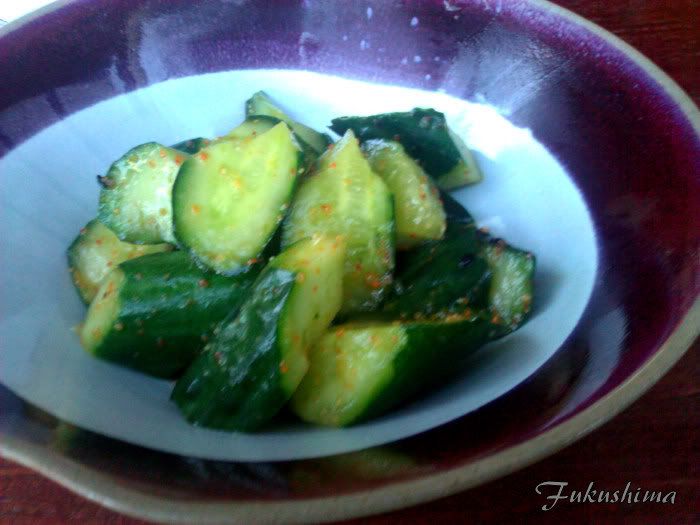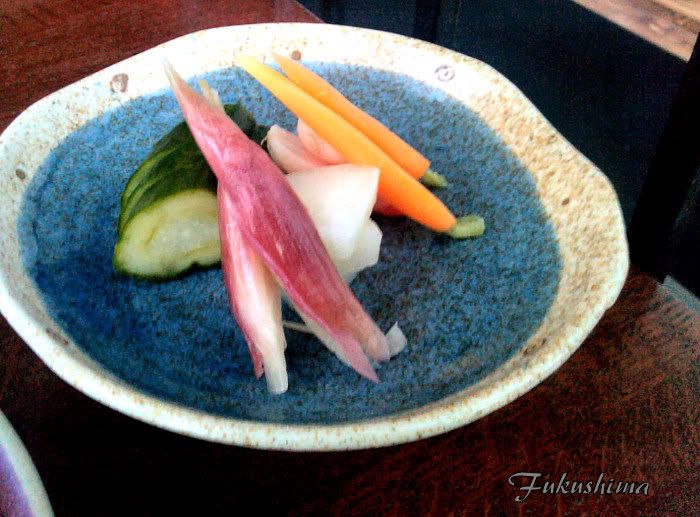Koji, which is a mold, is a traditional ingredient for making fermented foods in Japan, it is one of those ingredients that defines a cuisine, you truly do not have real Japanese food without the effects of Koji and it's by products of nuka, sake and shoyu. Yazuki has chosen to focus on these ingredients and the effect they have on aroma, taste and texture. And the effect was stunning to me.
I grew up in a American household, quite typical in many ways, but, the one way were varied widely from our surrounding culture was in our food. My grandmothers used ingredients, such as nuka, miso, shoyu and sake, these ingredients informed the aromas in our kitchens. We always had preserved, femernted and pickled vegetables that were in various stages of each process. This is the food of my childhood, and I rarely taste anything like it. I taste it at Yazuki. I ordered the Tsunemono and something called Pirikara Kuri, the first taste of the Pirikara brought me great pleasure, as it was both subtle yet had a depth and complexity that is hard to explain, the food had the spice from Shichimi, a complex chili powder typical of Japanese modern cuisine and the particular texture of aged Japanese pickles, that I can only describe as barely wilted.
Pirikara Kuri
Then there was the Tsunemono, the highlight of the night for me actually. I could have eaten just this and some great rice and my night would have been made. The taste and texture of these fermented vegetables, which are left in nuka, a fermented rice bran product. Called, more properly, Nukazuke, this dish was instantly as familiar as my childhood, the aromas and textures, as well as the very vegetables were what I associated with my grandmothers kitchens. Emotionally, this hit me in the heart. I live for moments like this, were a food or drink evokes memories, that are so tangible and real, not some distant fog of memory, but, a visceral reaction. At that point, I was alone at my table, eating pickles, dead sober and having the best dining experience of my year. Perhaps many years, as I was, in a very direct way, dining with my mother and grandmothers.
Tsunemono/Nukazuke
This is the power of food to me, I have rarely seen it. I can remember only a few time, the most recent being on my 40th birthday, my dads 77th birthday, when I could not be with him. My friends Arleigh and Diane brought a bottle of wine that recalled the scents of the old California Flower Market, it tasted of the air in the market, it brought tears to my eyes. Only one other time, when I saw my dad tear up, as he ate home made Satsuma Age and he mentioned how it tasted of his mother's cooking, have I seen something as emotionally satisfying. The power of an aroma or a taste, to transcend decades, to defy age, and to bring one back to that those feelings and memories.
The final dish that had this effect, a tofu, sukui tofu, a soft, freshly made tofu, which, as a result of not being aged, is so soft, it takes the shape of the basket in which it is made, is another all to rare dish, we can buy kinugoshi tofu, which is similar but lacks the delicacy and immediancy of the freshly made tofu. Usually served with condiments, in this case a flavored shoyu, flake salt and minced herbs of ginger, scallion and garlic, this dish was something that as a child, I hated. It was just not right, but, as an adult, I find tremendous satisfaction and joy in this dish. I cannot help but be reminded of all those times I pushed it away, only to be told by my parents that someday, you will love eating it. And they were right, again.
Sukui Tofu with Condiments
There were other dishes, all of which were very well executed and had a hallmark of the cuisine I grew up knowing as Japanese food, which is a subtlety in the flavors. Japanese cuisine in America is all too often adjusted to satisfy the much stronger flavors and textures of the American palate. The Japanese cuisine I grew up with has layers and flavors that float across the palate, but, they need to be considered. Each dish, even the tempura, which bore an amazingly delicate crust, not over every bit of the meat or vegetable, but, just enough to add a bit of crunch and flavor, the shoyu that was light and complex, even the use of green tea salt, a delicate complexity on normal salt, all spoke to a Japanese meal prepared in a Japanese manner.
A Glossary of Terms:
Shoyu - soy sauce in English
Miso - fermented bean paste
Kuri - Cucumber
Koji - a mold, one of two types of fungus used in production of sake, miso
Zuke - fermented vegetable
Tsunemono - 'pickled things', normally reserved for vinegar pickles
(and finally, sorry about the phone pics, terrible, I loaned my camera out to a friend running for office)



Myoga (the purple thing in the tsunemono) is my most recent favorite kind of pickle. :-)
ReplyDeleteI happen to love it now, hated it as a kid.
ReplyDelete